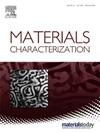热机械加工对磷青铜晶界特征分布的影响
IF 4.8
2区 材料科学
Q1 MATERIALS SCIENCE, CHARACTERIZATION & TESTING
引用次数: 0
摘要
晶界工程(GBE)被广泛用于改善面心立方体(FCC)金属的晶界特征分布(GBCD)。在磷青铜合金中,实现优化的 GBCD 同时保持足够小的晶粒尺寸对于保持高强度和优异的弯曲加工性至关重要。然而,迄今为止,GBE 过程中 GB 的精确演变和形成机制仍不清楚。本研究利用电子反向散射衍射和透射电子显微镜分析,研究了热机械加工(TMP)对磷青铜中 GBCD 优化和孪生相关畴(TRD)演化的影响。研究结果表明,应变诱导边界迁移(SIBM)在 GBCD 优化中起着关键作用。特别是,应变诱导边界迁移有利于在迁移的 GB 锋面后形成大量新的Σ3 边界,从而增加了特殊边界(SB)的比例,并引入了Σ9 和Σ27 边界等低能段。这些边界有效地破坏了随机高角度晶界(RHAGB)网络的连通性。此外,研究结果表明,优化 GBCD 的最佳 TMP 条件包括:还原度为 5%、退火温度为 450 °C、退火持续时间为 1 小时。在这些条件下,平均晶粒大小为 3 μm,GB 分数 fSBs 和 fΣ9+Σ27 分别为 81.3% 和 9.8%。变形微结构中形成的变形孪晶抑制了 TRD 的生长,从而阻碍了 GBCD 的优化。此外,GBCD 优化的最佳应变阈值位于变形孪晶形成的应变阈值附近。TRD 在初级再结晶过程中形成,而高阶孪晶边界则在生长过程中的迁移前沿后方形成。本文章由计算机程序翻译,如有差异,请以英文原文为准。
Effect of thermomechanical processing on the grain boundary character distribution of phosphorus bronze
Grain boundary engineering (GBE) is widely adopted to improve the grain boundary (GB) character distribution (GBCD) of face-centered-cubic (FCC) metals. In phosphorus bronze alloy, achieving an optimized GBCD while maintaining sufficiently small grain size is critical for maintaining high strength and excellent bending workability. However, the precise evolution and formation mechanisms of GBs during GBE remain unclear to date. Leveraging electron backscatter diffraction and transmission electron microscopy analyses, this study examined the effect of thermomechanical processing (TMP) on GBCD optimization and twin-related domain (TRD) evolution in phosphorus bronze. The results revealed that strain-induced boundary migration (SIBM) plays a pivotal role in GBCD optimization. In particular, SIBM facilitates the formation of abundant new Σ3 boundaries behind migrating GB fronts, thus increasing the proportion of special boundaries (SBs) and introducing low-energy segments such as Σ9 and Σ27 boundaries. These boundaries effectively disrupt the connectivity of the random high angle grain boundary (RHAGB) network. Furthermore, the results indicate that the optimal TMP conditions for GBCD optimization include a reduction level of 5 %, annealing temperature of 450 °C, and annealing duration of 1 h. These conditions result in an average grain size being <3 μm and the GB fractions fSBs and fΣ9+Σ27 being 81.3 % and 9.8 %, respectively. Deformation twins formed within the deformed microstructure inhibit TRD growth, thus hindering GBCD optimization. Additionally, the optimal strain threshold for GBCD optimization lies near the strain threshold for the formation of deformation twins. TRDs form during the primary recrystallization process, while high-order twin boundaries form behind the migration front during the growth process.
求助全文
通过发布文献求助,成功后即可免费获取论文全文。
去求助
来源期刊

Materials Characterization
工程技术-材料科学:表征与测试
CiteScore
7.60
自引率
8.50%
发文量
746
审稿时长
36 days
期刊介绍:
Materials Characterization features original articles and state-of-the-art reviews on theoretical and practical aspects of the structure and behaviour of materials.
The Journal focuses on all characterization techniques, including all forms of microscopy (light, electron, acoustic, etc.,) and analysis (especially microanalysis and surface analytical techniques). Developments in both this wide range of techniques and their application to the quantification of the microstructure of materials are essential facets of the Journal.
The Journal provides the Materials Scientist/Engineer with up-to-date information on many types of materials with an underlying theme of explaining the behavior of materials using novel approaches. Materials covered by the journal include:
Metals & Alloys
Ceramics
Nanomaterials
Biomedical materials
Optical materials
Composites
Natural Materials.
 求助内容:
求助内容: 应助结果提醒方式:
应助结果提醒方式:


